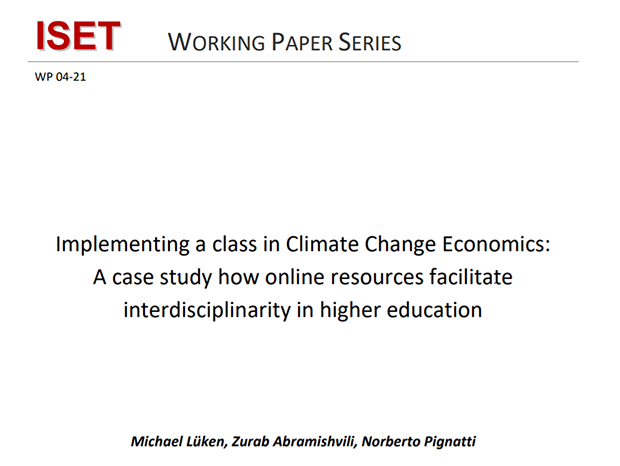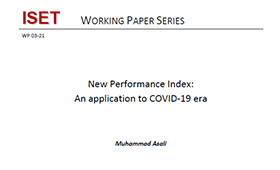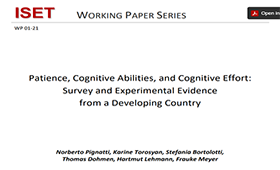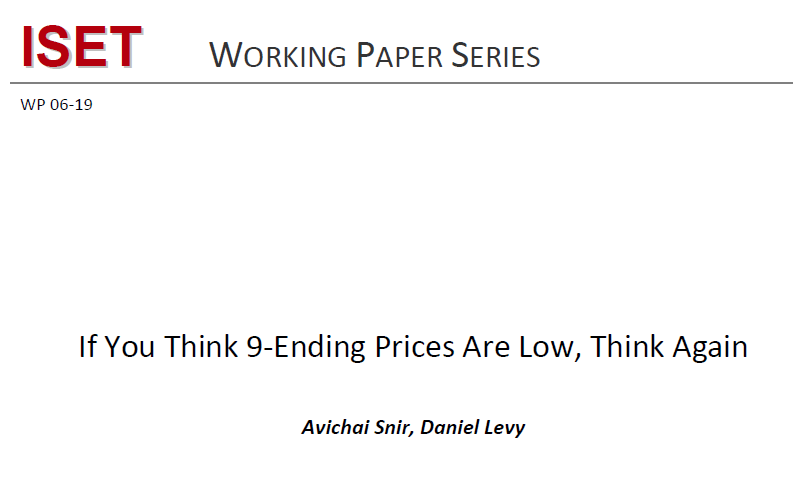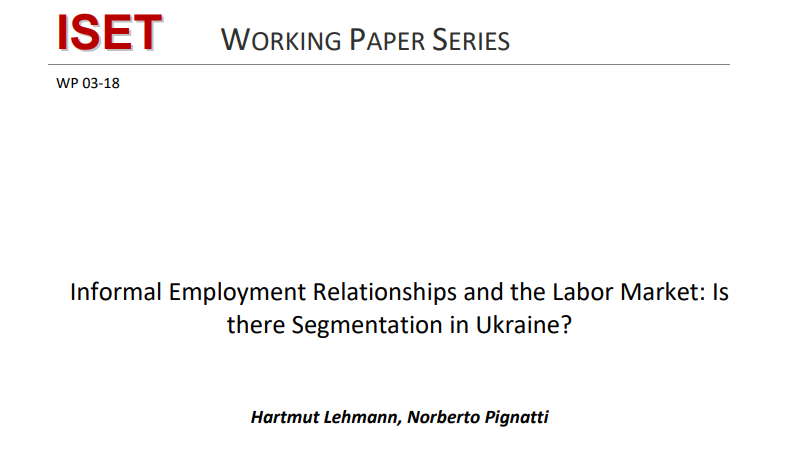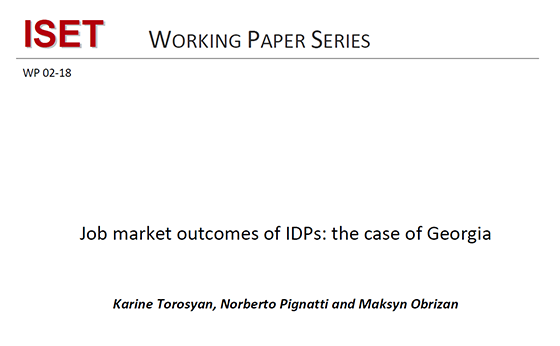Implementing a class in Climate Change Economics: A case study how online resources facilitate interdisciplinarity in higher education
by Michael Lüken, Zurab Abramishvili, Norberto Pignatti
Tackling human-made Climate Change is among the main global challenges today and in the coming decades. Due to the interdisciplinary structure of the topic, the integration of Climate Change into the relevant higher education programs still lags behind. Online teaching resources such as Massive Open Online Courses (MOOCs) might contribute significantly to overcoming this deficiency...
New Performance Index: An application to COVID-19 era
by Muhammad Asali
In this study I build a performance index that is based on different human capital components, as well as differences in the distribution of these components and of their returns between different genders and ethnic groups. The index can be calculated for individual industries in an economy; it can also be calculated for global economies...
Gender and ethnic wage differentials inhibit growth: A shred of evidence
by Muhammad Asali
Racial, ethnic, and gender wage differentials, in particular those that are not explained by human capital differences between the respective groups, are fixtures of labor markets in almost all countries, developed and developing alike. Discriminatory wage differentials have detrimental social and economic effects. Gender differentials have larger distortional effects than other ethnic and racial differentials, and might call for different policies to address them....
Patience, Cognitive Abilities, and Cognitive Effort: Survey and Experimental Evidence from a Developing Country
by Stefania Bortolotti, Thomas Dohmen, Hartmut Lehmann, Frauke Meyer, Norberto Pignatti, Karine Torosyan
We shed new light on the relationship between cognition and patience, by providing documenting that the correlation between cognitive abilities and delay discounting is weaker for the same group of individuals if choices are incentivized. We conjecture that the exertion of higher cognitive effort, which induces higher involvement of the cognitive system, moderates the relationship between patience and cognition. To test this hypothesis, we analyze the relationship between various measures of cognitive ability, including the cognitive reflection test (CRT)...
Employment vs. homestay and the happiness of women in the South Caucasus
byKarine Torosyan Norberto Pignatti
Modern women often face an uneasy choice: dedicating their time to reproductive household work, or joining the workforce and spending time away from home and household duties. Both choices are associated with benefits, as well as non-trivial costs, and necessarily involve some trade-offs, influencing the general feeling of happiness women experience given their decision. The trade-offs are especially pronounced in traditional developing countries, where both the pressure for women to stay at home and the need to earn additional income are strong, making the choice even more controversial.
The Georgian Tax Lottery of 2012. A Multi-Methodological Assessment
by Lotta Björklund Larsen, Rubina Arakelyan, Teimuraz Gogsadze, Mariam Katsadze, Sophiko Skhirtladze, Nino Muench
Tax lotteries are seen as ways to relatively easily augment public revenue while also increasing compliance. Tax lotteries are constructed so that consumers are nudged to ask for a receipt when making a purchase. This receipt contains information so that it can also be used as a lottery ticket with the possibility of winning prizes. Such tickets also leave traces of transaction records so that revenue authorities can audit vendors. Given this background, the aim of this paper is to provide a broad, multi-methodological and socio-economic assessment of Georgia’s tax lottery experience in 2012.
Pricing Better
by Sourav Ray, Li Wang, Daniel Levy, Mark Bergen
Electronic shelf label (ESL) is an emerging price display technology around the world. While these new technologies require non-trivial investments by the retailer, they also promise significant operational efficiencies in the form of savings in material, labor and managerial costs. The presumed benefits of ESL, for example, tend to be focused around lower price adjustment costs (PAC), also known as menu costs.
vgets: A program to estimate general-to-specific VARs, Granger causality, steady-state effects, and cumulative impulse responses
by Muhammad Asali
Vector Autoregression (VAR) estimation is a vital tool in economic studies. VARs, however, can be dimensionally cumbersome and overparameterized. vgets command allows for a general-to-speci c (GETS) estimation of VARs, overcoming the potential overparameterization, and provides tests for Granger causality, estimates of the long-run e¤ects and the cumulative impulse response of each variable in the system; it also o¤ers diagnostics that facilitate a genuine-causality interpretation of the Granger causality tests.
If You Think 9-Ending Prices Are Low, Think Again
by Avichai Snir, Daniel Levy,
9-ending prices are a dominant feature of many retail settings, which according to the existing literature, is because consumers perceive them as being relatively low. Are 9-ending prices really lower than comparable non 9-ending prices? Surprisingly, the empirical evidence on this question is scarce. We use 8 years of weekly scanner price data with over 98 million price observations to document four findings. First, at the category level, 9-ending prices are usually higher, on average, than non 9-ending prices.
Promise, Trust and Betrayal: Costs of Breaching an Implicit Contract
by Daniel Levy, Andrew T. Young
We study the cost of breaching an implicit contract in a goods market, building on a recent study that documented the presence of such a contract in the Coca-Cola market, in the US, during 1886‒1959. The implicit contract promised a serving of Coca-Cola of a constant quality (the “real thing”), and of a constant quantity (6.5oz in a bottle or from the fountain), at a constant nominal price of 5¢. We offer two types of evidence. First, we document a case that occurred in 1930, where the Coca-Cola Company chose to incur a permanently higher marginal cost of production, instead of a one-time increase in the fixed cost, to prevent a quality adjustment of Coca-Cola, which would be considered a breach of the implicit contract.
A Tale of Two Tracks
by Muhammad Asali
We provide a simple framework that helps explore the need for contingent (teaching) jobs in academia alongside the usual tenured-professorship positions. It also explainsWe provide a simple framework that helps explore the need for contingent (teaching) jobs in academia alongside the usual tenured-professorship positions. It also explainsthe coexistence of these two types of jobs in research universities as an equilibrium phenomenon. Imprecisions in the academic editorial process, combined with the increasing difficulty of producing academic research, is suggested as a possible explanation for the recent increasing trend in the share of non-tenure-track teaching jobs in academia aswell as the widening wage gap between tenured-professors and teaching faculty. Alternative interpretations are explored.
Selling Wine in Downtown: Who is the Urban Winery Consumer?
by Natalia Velikova, Phatima Mamardashvili, Tim H. Dodd, Matthew Bauman
Urban tasting rooms are a relatively new and growing phenomenon in the U.S. wine market. However, there has been little research concerning the specific marketing strategies that contribute to the success of urban wineries, including their desired target markets. The current study is an initial attempt to explore consumers’ choices of urban wineries. Based on the data obtained through an online survey (N = 1,412) incorporating a discrete choice experiment (DCE) with visual simulations, the study offers a profile of the urban winery consumer. Managerial implications, limitations, and suggestions for future research are included.
Labor Market Discrimination and the Macroeconomy
by Muhammad Asali, Rusudan Gurashvili
Using Integrated Household Survey data from Georgia, we measure the observable and discriminatory ethnic wage gap, among male and female workers, and the gender wage gap,Using Integrated Household Survey data from Georgia, we measure the observable and discriminatory ethnic wage gap, among male and female workers, and the gender wage gap,among Georgians and non-Georgians. The gender wage discrimination is larger than the ethnic wage discrimination. In the second estimation stage, these wage discrimination estimates are used in a general-to-specific vector autoregression framework to test for the Granger causality between discrimination and growth.
Not all price endings are created equal: Price points and asymmetric price rigidity
by Daniel Levy, Avichai Snir, Alex Gotler, Haipeng (Allan) Chen
We document an asymmetry in the rigidity of 9-ending prices relative to non-9-ending prices. Consumers have difficulty noticing higher prices if they are 9-ending, or noticing price-increases if the new prices are 9-ending, because 9-endings are used as a signal for low prices. Price setters respond strategically to the consumer-heuristic by setting 9-ending prices more often after price-increases than after price-decreases.
Informal Employment Relationships and the Labor Market: Is there Segmentation in Ukraine?
by Hartmut Lehmann, Norberto Pignatti
One of the most important factors that determine individuals’ quality of life and wellbeing is theirOne of the most important factors that determine individuals’ quality of life and wellbeing is theirposition in the labor market and the type of jobs that they hold. When workers are rationed out of theformal segment of the labor market against their will, i.e., the labor market is segmented, their qualityof life is limited, and their wellbeing is reduced. When they can freely choose between a formal orinformal employment relationship, i.e., the labor market is integrated, their wellbeing can reach highlevels even in the presence of informal employment. We, therefore, test whether the Ukrainian labormarket is segmented along the formal-informal divide, slicing the data by gender and age. Read more...
Job market outcomes of IDPs: the case of Georgia
by Karine Torosyan, Norberto Pignatti and Maksyn Obrizan
Internally displaced people (IDPs) constitute a serious economic, social and cultural problem for many countries, including countries in transition. Despite the importance of the problem, there are only a handful of previous studies investigating the issue of labor market outcomes of IDPs. We aim to fill this gap in the literature using 13 years of Integrated Household Surveys over 2004-2016 from Georgia, which experienced large flows of internal migrants from the early 1990s until now. Our analyses indicate that the labor market outcomes of IDPs are much worse than those of local residents. Specifically, IDPs are 3.9 to 11.2 percentage points less likely to be in the labor force, depending on the period and duration of IDP status. IDPs are also up to 11.6 percentage points more likely to be unemployed, sometimes even after 20 years of forced displacement. Finally, IDPs residing in a locality for more than 5 years receive persistently lower wages than local residents with similar characteristics, with the gap widening over time, reaching some 16 percentage points in the last period under analysis. Read more...
Here Lives a Wealthy Man: Price Rigidity and Predictability in Luxury Housing Markets
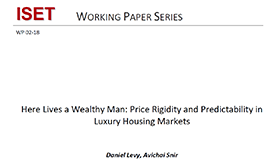
by Daniel Levy, Avichai Snir
We use novel and unique data to study the effect of price changes in the market for luxury and middle class homes. We find that luxury home sales respond less to price changes than the middle-class home sales; in the market for luxury homes, past prices affect current prices; luxury home prices persist; and prices of luxury homes are stickier than prices of middle-class homes. Recent macroeconomic models predict that housing markets can have counter-cyclical effect, if home prices are flexible. Our findings imply that home prices, especially luxury home prices, may not be flexible enough to generate such effect. Read more...
The International Spillover Effects of Political Transitions

by Yaroslava Babych
Why do political transitions to more representative forms of government are often associated with vastly different outcomes for different countries? This paper examines the possibility of cross-country “political spillovers”, testing in particular whether countries surrounded by relatively more autocratic neighbors also experience a more difficult economic adjustment process following democratization. The dynamic fixed effects model, estimated using the pooled mean group estimator methodology of Pesaran, Shin and Smith (1999) allows to account for both short and long-run effects of political spillovers between neighboring countries. In particular, the paper finds evidence that for countries which have experienced democratization, moving away from their neighborhoods on the political spectrum implies slower GDP per capita growth in the long run. Read more...
Do Political Regime Changes Help Predict Growth Takeoffs?

by Yaroslava Babych
Do political regime changes as well as the quality of political institutions help predict the turning points in a country’s growth history? I show that controlling for a variety of economic factors, both democratic and autocratic regime changes help predict growth “takeoffs”. However, I find evidence that countries with low levels of income per capita benefit less from democratizations. This threshold level of income is estimated using Hansen’s threshold regression methodology. The threshold regression approach also reveals non-linearities in the effect of trade openness and level of political development on growth. In particular, I find that countries in the mid-range of trade openness benefit the most from an increase in trade volumes. Read more...
Measuring Food Price Volatility in Georgia

by Salome Gelashvili, Patima Mamardashvili
Food price volatility is an important determinant of access to food. Given Georgia’s low self-sufficiency ratio (34%) and its dependence on international markets, Georgia has few mechanisms to control food price volatility, particularly when it is driven by international market conditions. The goal of this paper is to measure the price volatility of wheat, potato and maize flour in Georgia, and define major drivers of volatility through a time series analysis of retail prices of those three food products, which account for a significant share of households’ spending on food. Results of the analysis are expected to contribute to Georgia’s policy on food security, as well as agricultural policy in general. Read more...
An Impact Evaluation of Mass Replacement of School Principals in Georgia

by Zurab Abramishvili
This paper investigates how a unique education policy positively affected university enrollment rates of public school students in Georgia. In 2007, the Georgian government enacted legislation mandating the replacement of all public school principals under the assumption that the replacement of the principals with randomly assigning qualified candidates to public schools would fairly decentralize and improve school governance across Georgia. About half of public school principals were actually replaced with new candidates and a majority of them were assigned through a random allocation mechanism. Read more...
Military Service and Future Earnings Revisited

by Muhammad Asali
Utilizing particularities in the Israeli laws and regulations, that exempt married women and ultra-orthodox Jewish men from military service, we provide evidence about the effects of compulsory military service on future earnings of veterans. The quasi-experimental estimates suggest that women experience a 4.6 percent military wage premium, while men experience a premium of 11.6 percent. These effects are far smaller than those experienced by minority groups, confirming the common notion in this literature. Finally, the discrepancies we found between the naïve and the consistent estimates suggest that people who voluntarily avoid service are those who face the highest opportunity costs of service. Read more...
Employment Discrimination in Georgia: Evidence from a Field Experiment

by Muhammad Asali, Norberto Pignatti and Sophiko Skhirtladze
We provide experimental evidence about ethnic discrimination in the labor market in Georgia. We randomly assign Georgian and non-Georgian, male and female, names to similar resumes and apply for jobs as advertised in help-wanted web sites in Georgia. We find that gender has no effect on the probability of callback, but a job applicant who is ethnic Georgian is twice more likely to be called for a job interview than an equally skilled ethnic non-Georgian (Azeri or Armenian). The almost 100% gap in callbacks is statistically significant and cannot be abridged by having more experience or education. Both taste-based discrimination and statistical discrimination models are consistent with the evidence provided in this study. Labor market discrimination tends to aggravate in economic busts. Read more...
Toothless reforms? The remarkable stability of female labor force participation in a top-reforming country

by Norberto Pignatti, Karine Torosyan, Maka Chitanava
Low Female Labor Force Participation (FLFP) constitutes a foregone opportunity at both the macro and at the micro levels, potentially increasing the vulnerability of households and lowering the long-run development perspectives of a country. Most international organizations and national policy makers see low FLFP as a serious issue that needs to be addressed by adopting appropriate policies. We investigate the possible reasons of the remarkable stability of FLFP in a top-reforming upper-middle income country. Our goal is to disentangle the different forces at work and to draw useful lessons for the design of participation-enhancing policies. Using data from a nationally representative Household Survey covering the period 2003-2015, we employ Blinder-Oaxaca (Blinder, 1973 and Oaxaca, 1973) type... Read more...
Potterian Economics
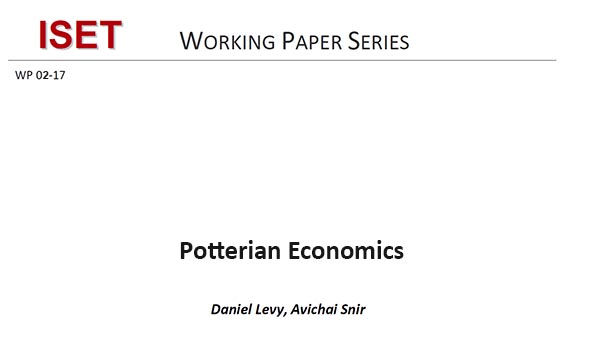
by Daniel Levy, Avichai Snir
Recent studies in psychology and neuroscience find that fictional works exert strong influence on readers and shape their opinions and worldviews. We study the Potterian economy, which we compare to economic models, to assess how Harry Potter books affect economic literacy. We find that some principles of Potterian economics are consistent with economists’ models. Many others, however, are distorted and contain numerous inaccuracies, which contradict professional economists’ views and insights, and contribute to the general public’s biases, ignorance, and lack of understanding of economics. Read more...
End of 9-Endings and Price Perceptions
by Daniel Levy, Avichai Snir,
We take advantage of a natural experiment to document an emergence of a new price ending that has the same effects as 9-endings. In January 2014, the Israeli parliament has passed a law prohibiting the use of non 0-ending prices. We find that one year after 9-ending prices have disappeared, 90-ending prices acquired the same status as 9-ending prices had before the law was passed. 90-ending prices became the new psychological price points. The retailers and the shoppers both reacted to the regulatory intervention optimally, which has eliminated the regulation’s intended effect. Read more...
Economic Growth in the Potterian Economy

by Avichai Snir, Daniel Levy
We study the economic structure of the life of Harry Potter and his co-actors as an economic model that governs the social organization of their economic activities. Our goal is to study and understand the internal consistency of the Potterian economic model and explore the relationships between its assumptions and the situation in the real world, as reflected in the Potterian model. To accomplish this, we focus on a textbook version of Solow’s economic growth model. The analysis of the Potterian economy reveals that the Potterian model fits quite well the predictions of the economic growth model. We discuss potential implications of this finding, and explore the link between Potterian economic structure and performance in a broader context by discussing the link between economic institutions and economic outcomes. Read more...
Explicit Evidence of an Implicit Contract
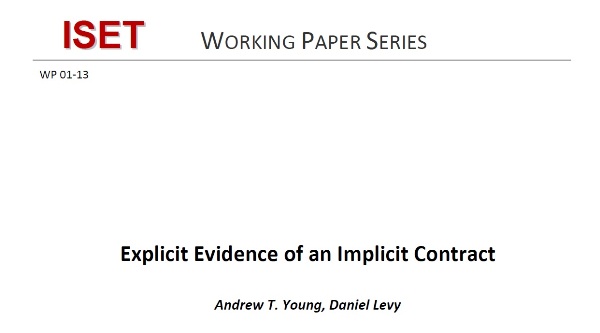
by Daniel Levy, Andrew T. Young
We offer the first direct evidence of an implicit contract in a goods market. The evidence comes from the market for Coca-Cola. We demonstrate that the Coca-Cola Company left a written evidence of its implicit contract with its consumers—a very explicit form of an implicit contract. The contract promised a 5¢ price and adherence to the “Secret Formula.” Because implicit contracts are unobservable, we adopt a narrative approach. Analyzing a large number of historical documents, we offer evidence of the Company both acknowledging and acting on this implicit contract. We explore quality as a margin of adjustment available to Coca-Cola. The implicit contract included a promise not only of a constant price but also a constant quality (the “real thing”). During a period of over 70 years, we find evidence of only a single case of true quality change. We demonstrate that the perceived costs of breaking the implicit contract were large. Read more...
Heterogeneous Convergence

by Daniel Levy, Andrew T. Young, Matthew J. Higgins
We use U.S. county-level data to estimate convergence rates for 22 individual states. We find significant heterogeneity. E.g., the California estimate is 19.9 percent and the New York estimate is 3.3 percent. Convergence rates are essentially uncorrelated with income levels. Read more...
An Application of the Growth Diagnostics Framework: The Case of Georgia

by Yaroslava Babych, Michael Fuenfzig
This paper applies the Growth Diagnostics framework and attempts to identify the binding constraints to economic growth in Georgia. While many policies potentially promote economic growth in practice only policies that relax the binding constraint do so. In contrast, policies that relax non-binding constraints will by definition do little or nothing to promote economic growth. This study builds on an existing growth diagnostics exercise by the Government of Georgia and the Millennium Challenge Corporation, but comes to different conclusions. Read more...
Almost Surely Convergent Summands of a Random Sum
 by S. Chobanyan, S. Leventalc, V. Mandrekar
by S. Chobanyan, S. Leventalc, V. Mandrekar
Published in: Statistics & Probability Letters, Volume 82, Issue 1, January 2012, Pages 212-216
We find a sufficient condition for a.s. convergence to zero of summands given that a sum of two sequences of random variables a.s. converges to zero. The condition turns out to be weaker than that used in the monograph by Loeve and in a paper by Martikainen. Our result is also used in construction of a counter-example regarding the a.s. convergence of a rearranged series. Read more...
A Measure to compare Matchings in Marriage Markets

by Florian M. Biermann
In matching markets the number of blocking pairs is often used as a criterion to compare matchings. We argue that this criterion is lacking an economic interpretation: In many circumstances it will neither reflect the expected extent of partner changes, nor will it capture the satisfaction of the players with the matching. As an alternative, we set up two principles which single out a particularly “disruptive” subcollection of blocking pairs. We propose to take the cardinality of that subset as a measure to compare matchings. This cardinality has an economic interpretation: The subset is a justified objection against the given matching according to a bargaining set characterization of the set of stable matchings. We prove multiple properties relevant for a workable measure of comparison. Read more...
Task Assignment with Autonomous and Controlled Agents
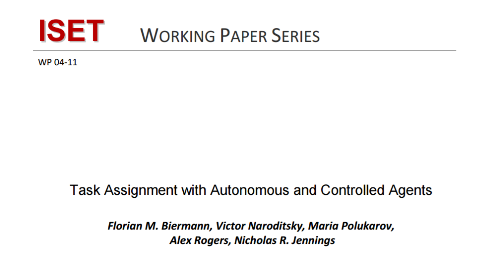
by Florian M. Biermann, Victor Naroditsky, Maria Polukarov, Alex Rogers, Nicholas R. Jennings
We analyse assignment problems in which not all agents are controlled by the central planner. The autonomous agents search for vacant tasks guided by their own preference orders defined over subsets of the available tasks. The goal of the central planner is to maximise the total value of the assignment, taking into account the behaviour of the uncontrolled agents. This setting can be found in numerous real-world situations, ranging from organisational economics to "crowdsourcing" and disaster response. We introduce the Disjunctively Constrained Knapsack Game and show that its unique Nash equilibrium reveals the optimal assignment for the controlled agents. This result allows us to find the solution of the problem using mathematical programming techniques. Read more...
Financial Crises and Economic Growth – A Long Run Perspective
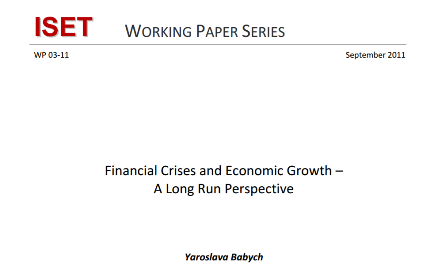
by Yaroslava Babych
In the economic literature the costs of financial crises are typically defined as cumulative output losses until the resolution of the crisis. Given this definition, majority of the empirical studies have documented significant economic costs associated with currency, banking and the twin crises. Few studies, however, looked at the long-term effect of various types of crises. In this paper I estimate the effect of currency, banking and twin crises episodes on the probability of initiating the periods of prolonged and significant growth spurs and downturns – the growth take-offs, and the growth collapses. Read more...
Transparency, Appropriability and the Early State

by Joram Mayshar, Omer Moav, Zvika Neeman
We propose a general theory that explains the extent of the state and accounts for related institutions as byproducts of the state’s extractive technology. We posit further that this extractive technology is determined by the transparency of the production technology. This theory is applied to examine two principal phases in the evolution of the early state. First, we argue that the common explanation of the emergence of the state as a consequence of the availability of food surplus due to the Neolithic Revolution is flawed, since it ignores Malthusian considerations. In contrast, we suggest that what led to the emergence of the state was a transformation of the tax technology that was induced by the greater transparency of the new farming technology. We then apply our theory to explain key institutional features that distinguished ancient Egypt from ancient Mesopotamia, and, in particular, to explain their different land tenure regimes. Read more...
Dynamic Contracts with Moral Hazard and Adverse Selection
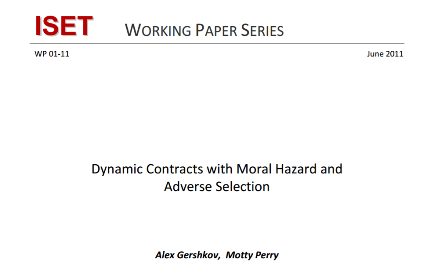
by Alex Gershkov, Motty Perry
We study a novel dynamic principal—agent setting with moral hazard and adverse selection (persistent as well as repeated). In the model an agent whose skills are his private information faces a finite sequence of tasks, one after the other. Upon arrival of each task the agent learns its level of difficulty and then chooses whether to accept or refuse each task in turn, and how much effort to exert. Although his decision to accept or refuse a task is publicly known, the agent’s effort level is his private information.
We characterize optimal contracts and show that the per-period utility of the agent approaches his per-period utility when his skills are publicly known, as the discount factor and the time horizon increase. Read more...
Remittances in Georgia: Correlates, Economic Impact, and Social Capital Formation

by Theodore P. Gerber, Karine Torosyan
Using a new data source, the Georgia on the Move Survey, we examine migrant-level, household-level, and contextual variables associated with the probability that a Georgian household receives remittances. We use propensity score matching to estimate how remittances affect particular types of household expenditures, savings, labor supply, health, and other measures of well being more precisely than is usually possible. Read more...
The Real Estate Conundrum in the CEE Office Markets: Thinking Too Big?

by Frederic Laurin, John-John D’Argensio, Thea Goginashvili
In this paper, we investigate the evolution of office market risks and property prices in Central and Eastern European (CEE) cities. We developed a methodology assessing if office property markets have been accurately valuated in CEE cities, using as a benchmark the past evolution of office markets in Western European cities. Read more...
Pricing Interrelated Goods In Oligopoly
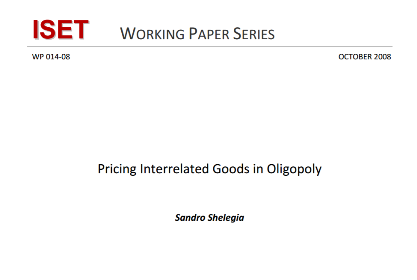
by Sandro Shelegia
In this paper we propose a two-good model of price competition in an oligopoly where the two goods can be complements or substitutes and each retailer has a captive consumer base a la Burdett and Judd (1983). Read more...
Do Immigrants Affect Labor Market Disparities?

by Muhammad Asali
This study exploits the natural experiment, provided by the start of the second intifada, to measure the e¤ect of immigration on labor market outcomes of Israeli-Arabs and Jews. Read more...
Inter‐Country Comparisons of Poverty Based on Capability Approach

by Muhammad Asali, Sanjay Reddy, Sujata Visaria
We argue that inter-country comparisons of income poverty based on poverty lines uniformly reflecting the costs of the basic requirements of human beings are superior to the existing money-metric approaches. Read more...
Wage Differentials in Israel: Endowments, Occupational Segregation, Discrimination, and Selectivity
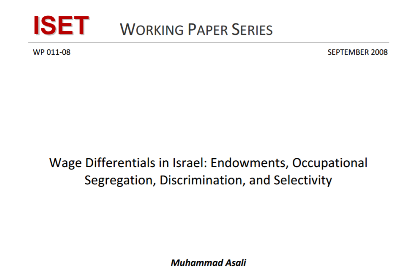
by Muhammad Asali
I use a panel of cross sections income data between 1991 and 2003 to measure wage differentials between Israeli-Arab and Jewish workers in Israel. The wage gap discovered is decomposed into components corresponding to human capital, occupational segregation, selectivity, and a residual, which may reect discrimination. Read more...
Trade and Migration: a U‐Shaped Transition in Eastern Europe

by Adolfo Cristobal‐Campoamor
This paper proposes a 2-country 3-region economic geography model that can account for the most salient stylized facts experienced by Eastern European transition economies during the 1990s. Read more...
Skill‐Upgrading and the Saving of Immigrants
 by Adolfo Cristobal‐Campoamor
by Adolfo Cristobal‐Campoamor
This note derives positive implications about the effect of immigration on labor income and the skill composition of the labor force in receiving economies. The novel mechanism through which immigration affects labor-market outcomes is the availability of new loanable funds for human-capital investment, which results in endogenous skill upgrading. Given their higher training costs in the host economy, immigrants usually do not acquire advanced academic skills, and they accordingly skip the financial costs of education at the college level. As a result, they self-select as net lenders, which reduces the equilibrium interest rates and facilitates the upgrading mostly of new generations of natives. Consequently, the aggregate labor income of natives increases with immigration. Read more...
International convergence and local divergence

by Adolfo Cristobal‐Campoamor
Published in: The Annals of Regional Science, Volume 43, Issue 2 (2009), page 527;
Abstract: This paper presents an East-West endogenous-growth model that reproduces recent stylized facts applicable to the trade liberalization process of many developing countries: convergence with the rest of the world, higher internal divergence, increasing spatial concentration of economic activity and higher growth rates. Read more...
Estimating Iceland’s Real Equilibrium Exchange Rate

by Robert Tchaidze
Given recent developments in Iceland, this paper evaluates its real exchange rate disequilibrium. It discusses three approaches to estimating the equilibrium values and suggests that the adjustment needed to bring the real exchange rate in line with fundamentals is in the range of 15-25 percent, although timing and manner of this adjustment is unclear. Read more...
The Use and Abuse of Taylor Rules: How Precisely Can We Estimate Them?

by Alina Carare, Robert Tchaidze
This paper draws attention to inconsistencies in estimating simple monetary policy rules and their implications for policy advice. We simulate a macroeconomic model with a backward reaction function similar to Taylor (1993). We estimate different versions of a policy rule, using these simulated data. Read more...
Linguistic Diversity and Redistribution
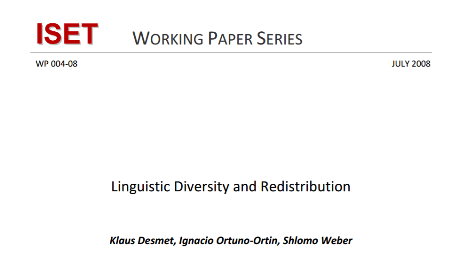
by Klaus Desmet, Ignacio Ortuño-Ortín, Shlomo Weber
This paper investigates the effect of linguistic diversity on redistribution in a broad cross-section of countries. We use the notion of "linguistic distances" and show that the commonly used fractionalization index, which ignores linguistic distances, yields insignificant results. However, once distances between languages are accounted for, linguistic diversity has both a statistically and economically significant effect on redistribution. With an average level of redistribution of 9.5% of GDP in our data set, an increase by one standard deviation in the degree of diversity lowers redistribution by approximately one percentage point. We also demonstrate that other measures, such as polarization and peripheral heterogeneity, provide similar results when linguistic distances are incorporated. Read more...
Stability of Nations and Genetic Diversity

by Klaus Desmet, Michel Le Breton, Ignacio Ortuño-Ortín, Shlomo Weber
This paper presents a model of nations where culturally heterogeneous agents vote on the optimal level of public spending. Larger nations bene¯t from increasing returns in the provision of public goods, but bear the costs of greater cultural heterogeneity. This tradeo® induces agents' preferences over di®erent geographical con¯gurations, thus determining the likelihood of secession or uni¯cation. We provide empirical support for choosing genetic distances as a proxy of cultural heterogeneity and by using data on genetic distances, we examine the stability of the current map of Europe. We then identify the regions prone to secession and the countries that are more likely to merge. Furthermore, we estimate the welfare gains from European Union membership. Read more...
Trade and Investment Cooperation in East Asia
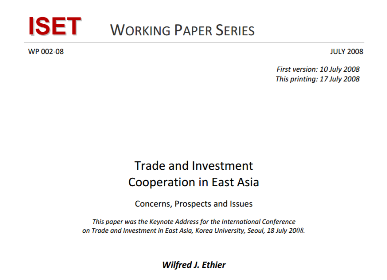
by Wilfred J. Ethier
This paper attempts to provide a context for the discussion of possible trade and investment cooperation is East Asia. First I describe the present role in the world economy of regional cooperative arrangements. These seem to be concerned primarily with foreign investment, secondarily with national economic-policy credibility, and thirdly with other issues, such as trade and migration. I discuss the changing role of East Asia in the global economy, especially with regard to the role of the multilateral trading system. This changing role raises the issue of possible East Asian cooperation, which I discuss in the light of the present function of regional arrangements. I attempt to identify potential benefits and dangers and the circumstances to which these are sensitive. Read more...
CONTACT US
16, Zandukeli St,
0108 Tbilisi,
Georgia
Telephone: (+995 32) 250 71 77
Email: info@iset.ge


